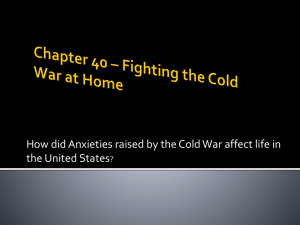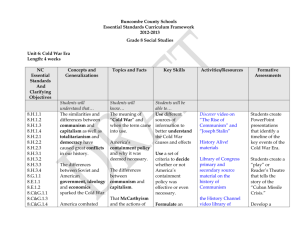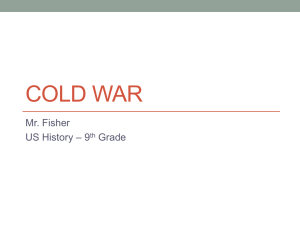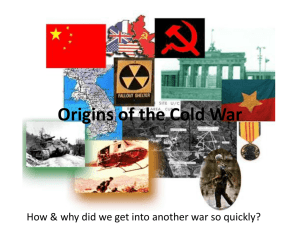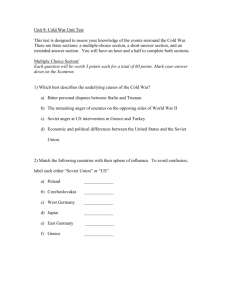Section Summary Key Terms Academic Vocabulary
advertisement
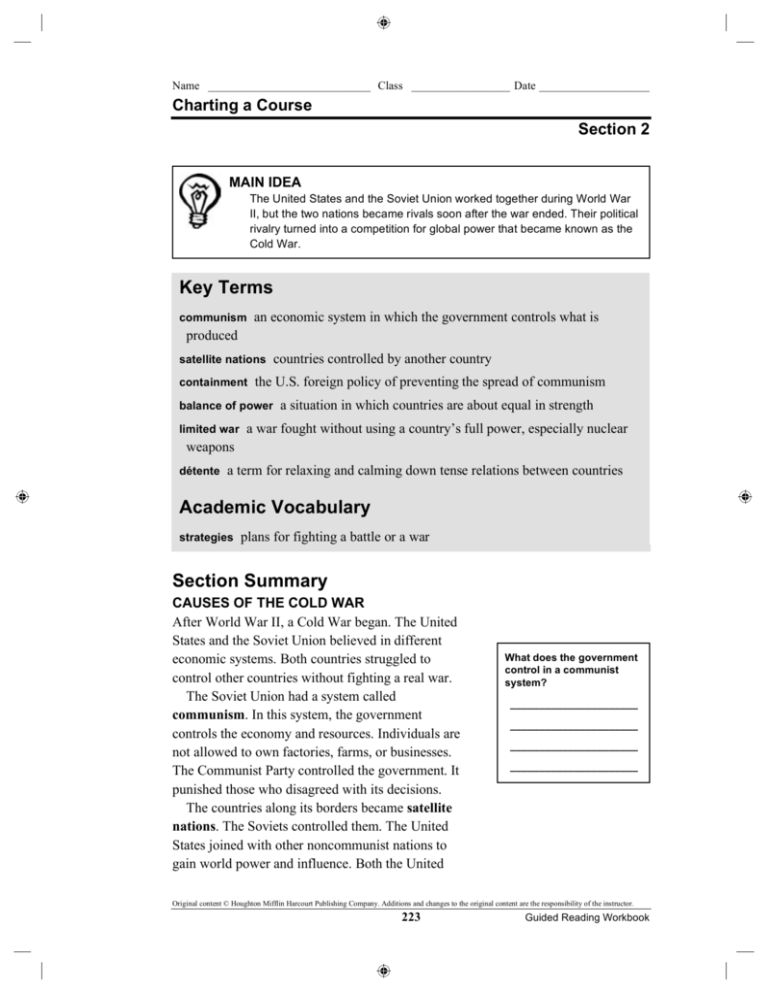
Name ____________________________ Class _________________ Date ___________________ Charting a Course Section 2 MAIN IDEA The United States and the Soviet Union worked together during World War II, but the two nations became rivals soon after the war ended. Their political rivalry turned into a competition for global power that became known as the Cold War. Key Terms communism an economic system in which the government controls what is produced satellite nations containment the U.S. foreign policy of preventing the spread of communism balance of power limited war countries controlled by another country a situation in which countries are about equal in strength a war fought without using a country’s full power, especially nuclear weapons détente a term for relaxing and calming down tense relations between countries Academic Vocabulary strategies plans for fighting a battle or a war Section Summary CAUSES OF THE COLD WAR After World War II, a Cold War began. The United States and the Soviet Union believed in different economic systems. Both countries struggled to control other countries without fighting a real war. The Soviet Union had a system called communism. In this system, the government controls the economy and resources. Individuals are not allowed to own factories, farms, or businesses. The Communist Party controlled the government. It punished those who disagreed with its decisions. The countries along its borders became satellite nations. The Soviets controlled them. The United States joined with other noncommunist nations to gain world power and influence. Both the United What does the government control in a communist system? ______________________ ______________________ ______________________ ______________________ Original content © Houghton Mifflin Harcourt Publishing Company. Additions and changes to the original content are the responsibility of the instructor. 223 Guided Reading Workbook Name ____________________________ Class _________________ Date ___________________ Section 2, continued States and the Soviet Union used strategies such as spying and foreign aid to “win” the Cold War. THE POLICY OF CONTAINMENT In 1947, President Harry S. Truman announced that the U.S. would give economic aid to countries that were fighting against communism. This is called the Truman Doctrine. The idea behind this policy was to prevent communism from spreading, or containment. The United States wanted to stop communism and keep the Soviet Union from occupying other countries. The Berlin Blockade tested this policy. The Soviet Union tried to block anyone and anything from coming into Berlin. The United States and Britain sent airplanes with food and supplies to Berlin. The Soviet blockade failed. In 1949, Communists gained power in China and Cuba and later in North Korea and North Vietnam. The Soviets supported these governments. They also showed the world they had nuclear weapons when they built missile bases in Cuba. The Soviet Union and the United States now had a balance of power. To try to contain communism, the United States fought a limited war in Vietnam and Korea. No nuclear weapons were used to fight the wars. THE END OF THE COLD WAR The Soviet Union spent too much money during the Cold War. Its economy was failing. Soviet leader Mikhail Gorbachev offered détente as a solution. This easing of tensions between the United States and the Soviet Union helped lead to the fall of communism. In 1991, the Soviet Union broke apart. The Cold War was over. What was the purpose of the policy of containment? _______________________ _______________________ _______________________ Underline the name of the policy that helped lead to the end of the Cold War. CHALLENGE ACTIVITY Critical Thinking: Evaluating Write a paragraph about how the world would be different today had communism not fallen in the Soviet Union. Original content © Houghton Mifflin Harcourt Publishing Company. Additions and changes to the original content are the responsibility of the instructor. 224 Guided Reading Workbook Name ____________________________ Class _________________ Date ___________________ Section 2, continued détente satellite nations balance of power strategies limited war containment communism strategies DIRECTIONS Use six of the words or phrases from the word list to write a summary of what you learned in the section. ____________________________________________________________________ ____________________________________________________________________ ____________________________________________________________________ ____________________________________________________________________ ____________________________________________________________________ ____________________________________________________________________ ____________________________________________________________________ ____________________________________________________________________ DIRECTIONS Look at each set of terms below. On the line provided, write the letter of the term that does not relate to the others. _____ 1. a. communism b. government control c. limited war d. ownership of resources _____ 3. a. détente b. satellite nations c. spread of communism d. containment _____ 2. a. Cold War end b. fall of Soviet Union c. détente d. balance of power _____ 4. a. balance of power b. Soviet republics c. limited war d. Cold War Original content © Houghton Mifflin Harcourt Publishing Company. Additions and changes to the original content are the responsibility of the instructor. 225 Guided Reading Workbook

